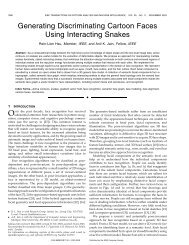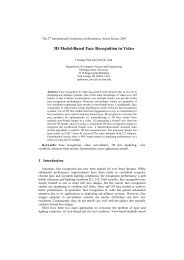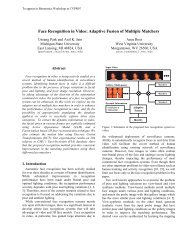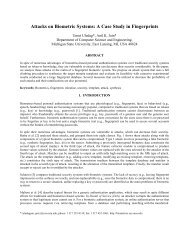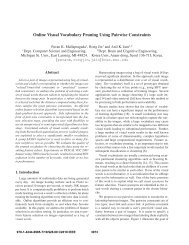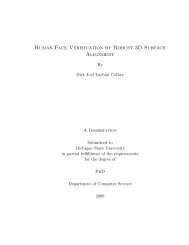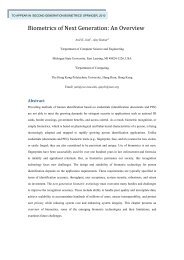Face Detection and Modeling for Recognition - Biometrics Research ...
Face Detection and Modeling for Recognition - Biometrics Research ...
Face Detection and Modeling for Recognition - Biometrics Research ...
You also want an ePaper? Increase the reach of your titles
YUMPU automatically turns print PDFs into web optimized ePapers that Google loves.
Figure 2.6. A breakdown of face recognition algorithms based on the posedependency,<br />
face representation, <strong>and</strong> features used in matching.<br />
ods, <strong>and</strong> shape-<strong>and</strong>-shape-free [104] methods belong to the hybrid approach which is<br />
derived from the PCA methodology. The EBGM-based methods belong to the hybrid<br />
approach that is based on 2D face graphs <strong>and</strong> wavelet trans<strong>for</strong>ms at each feature node<br />
of the graphs. Although they are in the hybrid approach category, the eigen-template<br />
matching <strong>and</strong> EBGM-based methods are much closer to feature-based approaches.<br />
In the pose-invariant algorithms, 3D face models are utilized to reduce the variations<br />
in pose <strong>and</strong> illumination. Gordon et al. [105] proposed an identification system<br />
based on 3D face recognition. The 3D model used by Gordon et al. is represented<br />
by a number of 3D points associated with their corresponding texture features. This<br />
method requires an accurate estimate of the face pose. Lengagne et al. [106] proposed<br />
a 3D face reconstruction scheme using a pair of stereo images <strong>for</strong> recognition <strong>and</strong> mod-<br />
45



